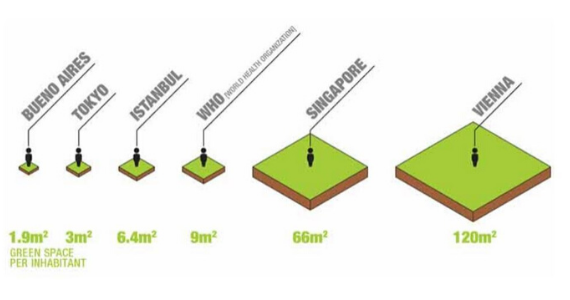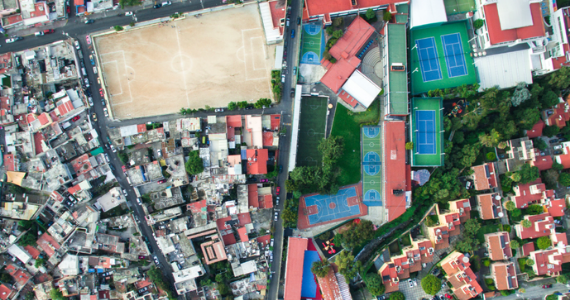The role of parks in healthy urban planning during the pandemic and beyond
Posted on
August 24, 2020
By: Dr. Mika Moran
SALURBAL Project
The current pandemic is changing how we think about public spaces and triggers important conversations on parks and how those should be designed to benefit the health and well-being of local populations. Parks and greenspaces contribute to environmental and human health in various ways ranging from heat and air pollution mitigation to physical activity promotion and psychological restoration. The health promoting potential of parks is amplified even more during the pandemic. With many people restricted to their homes, social isolation exacerbates, and with it, mental health problems arise, such as stress, anxiety, and depression. A walk in the park can alleviate these conditions through the mere exposure to green space, which reduces stress levels and improves mood and overall mental health well-being. It can also help cope with social isolation and feelings of loneliness by seeing others in the park, while keeping social distance. Being physically active outdoors can further increase our resilience to the Coronavirus by preventing and/or controlling chronic health conditions that are related to COVID 19, such as obesity, diabetes, and cardiovascular diseases.

Early on in the pandemic, these benefits were acknowledged and articulated by groups of experts in the UK and in the US who advocated for safe park use despite lockdowns and social distancing policies. Similarly, leading health agencies, such as the World Health Organization and the US Center for Disease control, called the public to get outside and do physical activity while maintaining social distance. Above all, the need to get outdoors at these times has been manifested by the public, as people flocked to parks more than ever before in many cities worldwide (for example in New York , Lima and Sao Paulo). To prevent overcrowding in parks, cities worldwide have closed streets for cars and have taken various social surveillance strategies such as limiting the number of park visitors and/or enforcing social distance between park visitors. Other strategies that are being discussed include extending parks hours after dusk, scheduling parks activities, and opening schoolyards and college campuses for outdoor recreation.
As the pandemic progresses and countries are gradually reopening, new strategies are being experimented to address increasing demands for public spaces. An example of one strategy that visually illustrates what social distancing outdoor recreation should look like is social distancing circles. These are circles painted on the grass at a safe distance between them to help park visitors safely enjoy the outdoors. Originally piloted in Brooklyn, New York, social distancing circles quickly spread to other cities in the US and Canada, and according to early reports, park visitors seem to use those circles properly. Despite its advantages, this new form of outdoors recreation is inherently different from what we know. Assigning park visitors to given spots eliminates the natural rhythm of human activities in parks, which may include walkers and joggers alongside people wandering, playing, talking, reading, or resting. Social distancing circles can be less practical for children who need space to run around and be active. It can also be less appealing for people living alone who feel socially isolated and visit parks in hope to alleviate their sense of loneliness. For those individuals, social distancing circles may further extenuate their sense of solitude, as sitting alone in a circle may feel more like outdoors quarantine than outdoors recreation. These conflicting influences illustrate varying needs of park users and the challenge in designing parks for social distancing outdoor recreation. As public spaces, parks provide opportunities for social interactions, which stand in contrast to social distancing. While social distancing recreation is critical during the pandemic, it may have negative effects on mental health and social well-being challenges, which are expected to increase post-pandemic.
Outdoor recreation in city parks during the pandemic

Source: Business Insider
The increasing demand for parks and public spaces is not new and it is profoundly noticeable in Latin America. A recently published SALURBAL study sheds light on the importance of parks in Latin American cities. The study used data from a survey held by the Development Bank of Latin America in 2016. According to the findings, urban residents were significantly more likely to visit parks on a regular basis, if they lived 10 minutes walking from a park (or less). While these associations may seem fairly intuitive, what drew our attention was their consistency across the board, suggesting that all residents, regardless of socioeconomic strata or neighborhood environment, would use parks more, if those were available nearby. Taken together with the overall deficit and unequal distribution of parks in Latin American cities, the study highlights the importance of park proximity to improve overall public health and to reduce health inequalities in Latin American cities.
Green space area per inhabitant (sq meters) in selected cities

Source: Pricetags
The paucity of parks and public spaces in low-income neighborhoods could contribute to other social determinants of health that explain socioeconomic disparities in COVID-19 incidence and mortality. This becomes critically pertinent given the ongoing rapid spread of COVID-19 in Latin American cities (as documented in SALURBAL COVID-19 dashboard) especially in communities experiencing extreme poverty, which further exacerbates existing profound inequalities in the region. Parks in low-income neighborhoods are fewer and smaller and thus are likely to get overcrowded faster thereby posing visitors at higher risk of infection. Park deficit in low-income neighborhoods can also have historical cumulative effects by reducing opportunities for habitual physical activity, which may, over time, increase the risk for background diseases related to COVID-19, such as obesity, diabetes, and cardiovascular diseases. Another recent SALURBAL paper discusses the risks of sever quarantine restrictions in deprived urban neighborhoods in Latin America and raises the need for regulations for safe park use as a critical public health priority.
Unequal distribution of outdoor and recreational facilities in Mexico City

Source: Unequal Scenes
Since we cannot predict when the pandemic will be over, discussions are shifting towards longer term solutions, such as increasing park area within cities. It has even been suggested that future parks should be designed based on the principle of maintaining 6 feet distance. Despite the environmental benefits of increased greenspace, planning only parks that are large enough to accommodate social distancing is both impractical and undesirable. Parks should come in all shapes and sizes and offer a wide variety of experiences and activities that can be enjoyed by heterogeneous urban populations. While larger parks can accommodate various activities, ranging from walking/biking to sport games and city events, smaller parks also have important health benefits and contribute to neighborhood social interactions. From an urban planning perspective, a fair distribution of neighborhood and pocket parks across the city is important to ensure that all residents have access to parks in a walkable distance from their home.
Overall, our experience thus far in the pandemic highlights the essential role of parks and park equity as part of a larger healthy urban planning agenda. Park design strategies in response the pandemic illustrate in a nutshell some of the core challenges of healthy urban planning. As an approach, healthy urban planning targets multiple health outcomes, rather than a single disease. However, health problems during and post-pandemic are inherently different, and thus may require different, or even opposing, environmental interventions. While social distancing outdoor recreation is imperative to contain the pandemic, it is important to also account for its potential implications on anticipated post-pandemic challenges in mental health and social well-being. Finally, and above all, insufficient parks access in low-income communities emerges as a potential contributor to their higher risk for COVID-19. This raises the need to recognize park equity as an urban health priority and to revisit strategies to increase park access in deprived communities during the pandemic and beyond.
